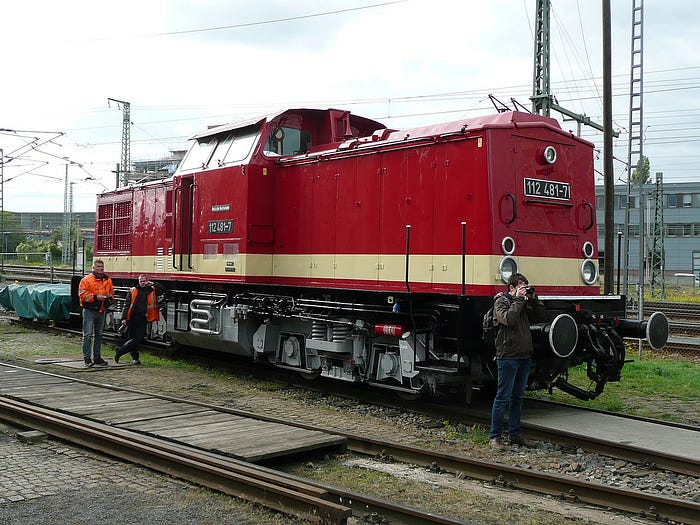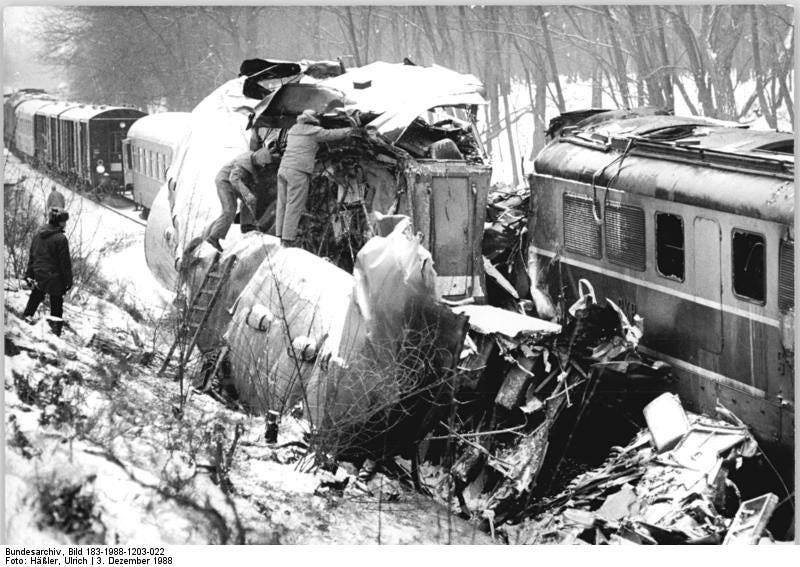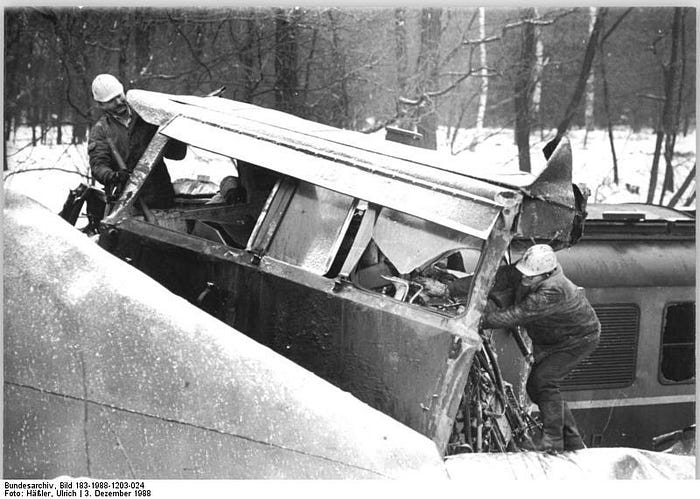
Background
Horka is a municipality of 1673 people (as of December 2020) in the extremely far east of Germany, located just 7km/4mi west of the Polish border and 64km/40mi southeast of Cottbus.

Passing through Horka from east to west is the Węgliniec–Roßlau railway, a double-tracked electrified main line opened in 1875. After the second world war part of the railway fell into Polish territory, with the route being reduced to a single track in 1946 as the passenger services on the connection were cancelled. Now only freight trains and trains carrying railway-staff, customs-officials, and/or transporting rolling stock were allowed to use the railway between Horka and the Polish territory. With the route through the forest being single-track trains would always meet either in Horka on the eastern German (DDR) side or in Bielawa Dolna on the Polish side.

The trains involved
Travelling eastbound towards Poland was Dstp 2241, a staff-train consisting of a locomotive and 3 passenger cars with 9 employees of the DR (National Railway of Eastern Germany/the DDR). Pulling the lightweight train was a DR Series V100 diesel-locomotive. Introduced in 1966 these 64 metric ton four-axle locomotives pulled both freight trains and passenger trains, being able to reach up to 100kph/62mph. They were part of an effort by the DR to retire steam engines from regular service, filling the role of light to medium weight trains as well as heavy shunting work.

Coming the other way was the Transit Freight Train TDg 45508, a long and heavy coal-train from the Polish national railway (PKP) pulled by a Series ST43. Introduced into service in 1965 these 116 metric ton six-axle freight locomotives weigh 116 metric tons at 17m/56ft long and can pull their trains at up to 100kph/62mph thanks to a 1544kw/2070hp 12 cylinder diesel engine.

The accident
On the 3rd of December 1988 at approximately 7:30am an ST43 with a heavy coal train is approaching Bielawa Dolna station, from where it will cross the border into Germany and proceed to Horka. At the same time a V100 was waiting on the German side at Horka’s freight yard, 8.6km/5mi down the track, pulling Dstp 2241. The driver of the freight train is alone on his train, while the German train carries a driver and 10 passengers. At 7:33am the Dispatcher on the German side (named Mister G. in all sources) calls his Polish colleague on the railway-exclusive phone-line, confirming the scheduling and announcing the arrival of the German train in a few minutes. The Polish Dispatcher confirms the schedule, designating the track to be safe and gives his coworker permission to turn the signal green, dispatching the train. A short passenger train is nothing difficult for the heavy freight locomotive even in the snowy conditions, and the German train departs Horka’s freight yard at 7:36. The German dispatcher reports this to his colleague accordingly. The constant exchange of information is important, the German trains at the time have no radio system and there is no modern block system keeping trains separate, meaning the dispatchers have to ensure safe operation. However, on this day, something went wrong. 7 Minutes after the German train departs Horka the phone in the signal box rings. Mister G picks up and hears a panicked Polish dispatcher rattle off a wild mixture of German and Polish. The fatal information: The freight train has passed the red signal. And with that, a collision was unavoidable. The Polish dispatcher tells his colleague to stop the train via radio, not knowing that only his side has that luxury at the time. It’s unknown if the Polish dispatcher managed to contact the freight train, either way it doesn’t make a difference. The two trains collide head-on at 7:44am, with the impact completely destroying the V100. Both drivers are killed on impact, along with 6 of the passengers in the German train. Spilling fuel starts a fire, eventually burning down both locomotives and part of the German train.


Aftermath
Two truck drivers happen to pass over the track on a bridge just seconds after the collision, only a few meters away. They drive off to find a telephone to call for help, the dispatchers on both sides do the same thing. Several fire departments head into the woods to help, as well as forest workers and emergency trains from Germany and Poland. Cutting the mangled passenger cars open 4 people can be pulled from the wreckage alive, 2 Germans and two Polish citizens. The crane brought in by the DR finds itself unable to pull the wreckage apart, later in the day a nearby officers school sends an armored recovery vehicle (think of a tank, but with a crane or winch instead of a large gun) and the wreckage can be pulled apart at last. At the time the accident is largely kept quiet in the media, the railway line is back to normal operation within a week while investigators go looking for the cause.
It’s clear that the Polish train was at fault, it evidently ran a red signal. But with the driver dead and there being no data-logging at the time it can never be clarified why he did so. In 1990 the investigation ends without a definitive cause named. Examining the freight cars showed that the pneumatic brake system was damaged, but on paper the train should’ve still had enough braking power to stop at the signal, or maybe slightly past it (but in safety). In the end the report lists two causes, the initial one being that the freight train ran a red signal and a secondary cause being the absence of a radio-system to warn the drivers. Unofficially it’s rumored that in 1988 the DDR wasn’t doing too well already, so money that could’ve gone into installing radios in the DR’s locomotives was spent elsewhere instead. A few years later radios became mandatory for trains in Germany, and nowadays the “Indusi”-System which can stop a train after running a red signal is found all over Germany also. With that, there cannot be a repeat of the events.

The Węgliniec–Roßlau railway, returned to double-track status and electrified in 2001, is still an important freight-route for trains headed to and from eastern Europe today, while passenger service (which was halted between 2002 and 2018) plays a very minor role. Trains carrying railway employees stop in 1998, since then employees have to take regular passenger trains or, if there is no connection, go by car.
The Polish ST43 is retired in 2019 due to a lack of spare parts. Towards the end of their era the thirsty, loud locomotives were obsolete due to advancing electrification of freight routes.
After German reunification the DDR’s V100 is essentially obsolete too, and most are retired starting in 1992. Today only a handful of the 1146 locomotives are still in existence, except for one in a museum (pictured further up) all of them are in private hands and have been modernized.

_______________________________________________________________
